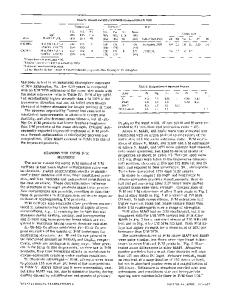Study of microstructure and mechanical property heterogeneity throughout the wall thickness of high strength aluminum al
- PDF / 1,338,526 Bytes
- 10 Pages / 584.957 x 782.986 pts Page_size
- 91 Downloads / 303 Views
Study of microstructure and mechanical property heterogeneity throughout the wall thickness of high strength aluminum alloy thick-wall pipe Gaoyong Lin1,a), Weiyuan Song1, Di Feng2, Kun Li1, Yongping Feng3, Jinxia Liu3 1 School of Materials Science and Engineering, Central South University, Changsha, Hunan 410083, People’s Republic of China; and Key Lab of Nonferrous Materials, Ministry of Education, Central South University, Changsha, Hunan 410083, People’s Republic of China 2 Department of Materials Science and Engineering, Jiangsu University of Science and Technology, Jiangsu 212003, People’s Republic of China 3 Fujian Xiangxin Shares Co., Ltd., Fuzhou 350000, People’s Republic of China a) Address all correspondence to this author. e-mail: [email protected]
Received: 2 January 2019; accepted: 25 March 2019
Differences in pipe wall microstructure at various positions throughout the wall thickness of high strength aluminum alloy thick-wall pipes produced by reverse hot extrusion were investigated. The microstructures of the inner wall (IW), outer wall (OW), and half wall (HW) were compared. Further, heterogeneity in the mechanical properties of the pipe throughout the wall thickness was also investigated. Results revealed that the volume fraction of precipitation was highest at the HW position because of the higher Zn and Mg contents. Further, approximately 26% of grains were recrystallized in the OW position due to the greater strain during extrusion, while the recrystallization fractions of the IW and HW positions were 13% and 21%, respectively. The effects of precipitation strengthening and deformation strengthening contribute to the highest ultimate tensile strength and Vickers hardness of the HW position, and to the higher elongation of the IW and OW positions.
Introduction Due to their low density, high strength, high fracture toughness, and excellent resistance to fatigue crack propagation after applicable deformation and heat treatment [1, 2], high strength aluminum alloys have attracted considerable attention in the aerospace industry. AlZnMgCu is an age-strengthening alloy; the main hardening phases of the alloy are the Guinier-Preston (GP) zone and the metastable g9 (MgZn2) phase [3, 4, 5]. The Zn and Mg contents, the copper content segregation [6], and the aging temperature field gradient [7] play a crucial role in controlling the precipitation behavior and mechanical properties of high strength aluminum alloys. Further, Fe and Si impurities give rise to the formation of a coarse second phase, such as Al7Cu2Fe, a-AlFeSi, and Mg2Si, in as-cast high strength aluminum alloys. The segregation of Fe and Si impurities also results in heterogenous coarse phase distribution [7, 8, 9]. Additionally, thermo-mechanical treatment leads to temperature gradient and strain gradient during deformation, which results in different dynamic softening behaviors and heterogeneity in the degree of recrystallization. A residual second phase
ª Materials Research Society 2019
and high degree of recrystallization can degrade
Data Loading...











